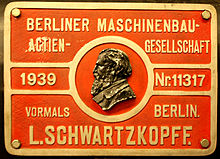Berlin mechanical engineering

The Berliner Maschinenbau AG ( BMAG , full Company : Berliner Maschinenbau-Actien- company formerly L. Schwartzkopff , Berlin ) was a German mechanical engineering company and is mainly due to the production of steam locomotives known. Long before the First World War , BMAG was the first company in the German Reich to begin its own development of torpedoes and was an important supplier of these weapons in both World Wars.
history
From the foundation to 1945
On October 3, 1852, Louis Schwartzkopff founded the iron foundry and machine factory of L. Schwartzkopff in Chausseestrasse 20 in the Oranienburger suburb of Berlin near the Szczecin train station . After a fire in 1860 and the expansion of the factory in Berlin's " Tierra del Fuego " one began with the production of turntables , water systems and switches for several railway companies. The first Schwartzkopff steam locomotive was delivered to the Lower Silesian-Märkische Eisenbahn on February 1st, 1867 . In the same year, the “New Plant” opened at what was then Ackerstraße 96 (later Scheringstraße 28), which until mid-1874 produced around 150 locomotives a year.
A separate electrotechnical department was added in 1885 in order to be able to manufacture dynamos, motors, transformers, switchgear and complete power generation systems such as ship equipment. The plant in Wildau was built from 1897 and two years later the locomotive and general mechanical engineering (steam engines, compressors, etc.) gradually moved there from Berlin. The torpedo production remained at the Ackerstrasse plant and the administration at Chausseestrasse. From 1899 the company also built Linotype typesetting machines for the Berlin-based Mergenthaler Setzmaschinen-Fabrik GmbH .A cooperation with the Munich company Maffei began on July 4, 1907. In addition to the existing plant in Wildau, Maffei-Schwartzkopff-Werke GmbH (MSW) was opened for this purpose . It was there that the construction of electric locomotives and their equipment began in 1910 . Diesel locomotives followed in 1924 . In 1932 Maffei-Schwartzkopff-Werke GmbH went into liquidation .
Berliner Maschinenbau-Actien-Gesellschaft
On July 1, 1870, the company was converted into a stock corporation and now traded under the name Berliner Maschinenbau-Actien-Gesellschaft formerly L. Schwartzkopff, Berlin . Louis Schwartzkopff was general manager until June 30, 1888; his successor was Emil Kaselowsky, brother of Ferdinand Kaselowsky .
Torpedoes
Berliner Maschinenbau AG presented its first torpedo in 1876 . The weapon made of phosphor bronze with a caliber (Ø) of 350 mm was equipped with a warhead of 14 kg. With a weight of 273 kg she was 4.5 m long and had a running distance of 400 meters at 17 knots (kn) speed. For torpedo production, the Ackerstraße plant was extensively expanded in the 1880s and the first type C / 84 torpedo (Ø 350 mm; length 4.67 m; weight 270 kg; load 20 kg; 22.5 kn at 400 m) in 1884 delivered to the German Imperial Navy . In August 1888, the 2000th BMAG torpedo ("Schwartzkopff type") was delivered. Since the Kingdom of Italy placed a larger order for its navy for the new product, the foundation stone was laid for a BMAG branch in Venice in May 1887 . After the lack of further orders from the German and Italian navies, it had to cease operations in January 1901 and was sold to the Italian state in 1902. Due to the high demand of the Imperial Navy during World War I, BMAG built new workshops on Zinnowitzer Strasse in 1916 on the area of the old Berlin headquarters, which had been largely cleared as early as 1906.
After the Second World War
After the destruction of the Berlin factory halls during the Second World War and the subsequent dismantling of the plants in Berlin and Wildau, the construction of locomotives at Berliner Maschinenbau AG ended in 1945. On September 20, 1945, the production of cast iron parts, Linotype typesetting machines and bottle blowing machines began in the rest of the plant . In 1961 the Moorburger Treckerwerke were acquired and their production changed. In 1966 the Berliner Maschinenbau AG was merged into DIAG , the Deutsche (n) Industrieanlagen Gesellschaft mbH .
Locomotive program
Berliner Maschinenbau AG was involved in the construction of the following locomotives:
- Prussian P 4
- Prussian P 6
- Prussian P 8
- Prussian S 3
- Prussian S 10
- Prussian T 16
- DR series 01
- DR series 01.10 (also draft)
- DR series 03
- DR series 41 (also draft)
- DR series 43
- DR series 52
- DR series 71
- DR series 84 (also draft)
- DR series 89.0
- DR series 99.22
- DR series E 77
- DR series E 75
- Wehrmacht locomotive WR 200 B 14
- Wehrmacht locomotive WR 360 C 14
- Wehrmacht locomotive WR 550 D 14
literature
- Eberhard Rössler : The torpedoes of the German submarines . Koehler, Herford 1984, ISBN 3-7822-0328-3 .
Web links
Individual evidence
- ↑ BMAG share from 1932 , at nonvaleur-shop , accessed on March 7, 2015
- Jump up ↑ covenant against evil . In: Der Spiegel . No. 34 , 1966, pp. 33 ( online ).



